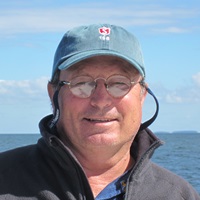
Tom Hale is a Chesapeake Bay cruiser and writer for Chesapeake Bay Magazine and PropTalk who has lived on the Chesapeake and cruised the Bay—and beyond—for 30 years.
He is just returning to the Bay from an overwinter cruise to the Florida Keys—down to Marathon and back.
“We are so looking forward to getting back to the Chesapeake. The round trip to the Keys is 2,500 miles or so and with a few side trips, we have probably traveled 3,000 miles since we left the Bay,” Hale detailed. “There is no place like the Chesapeake on the entire East Coast.”
From March through December, Hale generally sticks to cruising the Bay from Havre de Grace to Norfolk every weekend in season. Because of this range, CBIBS data—especially from the Stingray Point, Annapolis, and Potomac buoys—is extremely useful for him.
“If I am going to cross the mouth of the Potomac, I keep a close eye on that buoy to track changes in wave height. This part of the Bay can get rougher than any other part of the Bay. We prefer cruising in the southern Bay where there are fewer boats and so many scenic anchorages,” Hale noted. “CBIBS allows us to see the weather up north before it arrives.”
“All the national and local weather forecasts are fine, but to make important decisions, particularly when the weather is suboptimal, it is necessary to have real-time meteorological and oceanographic information. The buoy system adds important input that makes our cruising decisions better and our boating more enjoyable and no doubt also safer,” he said.
Hale and his crew use CBIBS data, accessed via the website, for planning cruising destinations and routes and updating route planning for friends. He also uses CBIBS for researching oceanographic information as he writes cruising articles. Hale also relies on the Chesapeake Bay Operational Forecast System (“CBOFS”).
Most often, though, he is on the go, so his smartphone is his source for real-time updates while he is cruising, focusing on wind speed, current speed and direction, wave height, and water temperature.
Hale first heard about the buoys when he saw one of them out on the Bay, and called the 877-BUOY-BAY toll-free phone number displayed on the side of the buoy. That led him to visit the website, where he saw the wealth of information it delivers.
“I go to the buoys just to see what the Bay is like when I’m not there,” he exclaimed.
While it’s fun to be able to “experience” the Bay from somewhere completely different, Hale sees the primary value of CBIBS buoys as being their contribution to safety.
“There can be no doubt that boating safety is enhanced by having real time reporting from these buoys. I have learned a lot about the Bay from this resource and it is a great education tool.”


